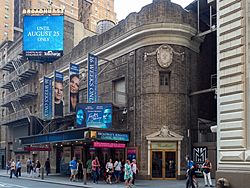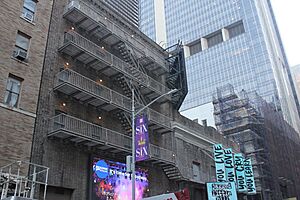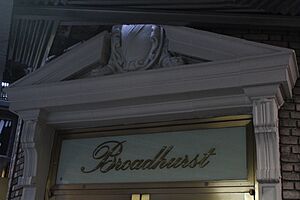Broadhurst Theatre facts for kids

Playing Frankie and Johnny in the Clair de Lune, July 2019
|
|
| Address | 235 West 44th Street Manhattan, New York United States |
|---|---|
| Coordinates | 40°45′30″N 73°59′15″W / 40.7582°N 73.9876°W |
| Owner | The Shubert Organization |
| Type | Broadway |
| Capacity | 1,218 |
| Construction | |
| Opened | September 27, 1917 |
| Architect | Herbert J. Krapp |
| Designated | November 10, 1987 |
| Reference no. | 1323 |
| Designated entity | Facade |
| Designated | December 15, 1987 |
| Reference no. | 1324 |
| Designated entity | Auditorium interior |
The Broadhurst Theatre is a famous Broadway theater located at 235 West 44th Street in the Theater District of Midtown Manhattan in New York City. It first opened its doors in 1917. The theater was designed by Herbert J. Krapp for the Shubert brothers. It is named after George Broadhurst, a British-American theater producer who planned to use the theater for his own shows.
The Broadhurst Theatre has 1,218 seats spread across two levels. It is managed by The Shubert Organization. Both the outside (facade) and the inside (auditorium) of the theater are considered New York City landmarks. This means they are protected because of their historical importance.
The outside of the theater looks simple and classic, similar to the nearby Schoenfeld Theatre. It is made of light-colored brick and terracotta. The inside of the theater is decorated in old Greek and Adam styles, with fancy columns and designs.
The Shubert brothers built the Broadhurst Theatre after their other theaters, the Booth and Shubert, became very successful. The Broadhurst Theatre has hosted many different types of shows over the years, including musicals, comedies, and dramas. Some of the long-running shows that have played here include Fiorello!, Cabaret, Grease, Les Misérables, and Mamma Mia!.
Contents
Where is the Broadhurst Theatre?
The Broadhurst Theatre is located at 235 West 44th Street. It's on the north side of the street, between Eighth and Seventh Avenues. This area is very close to Times Square in the Theater District of Midtown Manhattan, New York City.
The Broadhurst Theatre is surrounded by many other theaters. To its west is the Majestic. To the northwest are the John Golden and Bernard B. Jacobs theaters. The Gerald Schoenfeld is to the north, and the Booth and Shubert are to the east. This block has the largest number of Broadway theaters in one place!
The Shubert brothers built the Broadhurst and Schoenfeld theaters together. They used land that was left over after building the Shubert and Booth theaters.
How the Theatre Was Designed
The Broadhurst Theatre was designed by Herbert J. Krapp in 1917. It was built for the Shubert brothers. The Broadhurst and the Plymouth (now Schoenfeld) were some of Krapp's first theater designs on his own.
The outside of the Broadhurst Theatre is simple, made of brick and stone. It has a curved corner facing Broadway, which was helpful because most people came from that direction. This simple design was common for theaters Krapp built for the Shubert family.
The Theatre's Outside Look
The bottom part of the theater's outside is made of granite and terracotta. The rest is made of light-colored brick. On 44th Street, there are glass and bronze doors that lead inside. A large sign, called a marquee, hangs above these doors. The curved corner of the building also has an entrance to the ticket lobby.
On the second and third floors, there is a fire escape made of metal. This fire escape has doors and windows that open onto it. Above the third floor, there are decorative designs made of terracotta.
The stage area of the theater is five stories tall. It also has metal fire escapes and windows on each floor.
Inside the Auditorium
The Broadhurst Theatre's auditorium has a main floor (called the orchestra level), a large balcony, and special box seats. The inside is decorated with plaster designs. The Shubert Organization says the theater has 1,218 seats.
Seating Areas
At the back of the orchestra level, there's a wide area called a promenade. It has columns that support the balcony above. Two staircases lead from this promenade up to the balcony. The orchestra floor slopes down towards the stage, where there's a space for the orchestra to play music.
The balcony also has columns at the back. The side walls have decorative plaster panels. Underneath the balcony, there are more designs and air-conditioning vents. In front of the balcony, there's a long decorative strip called a frieze, which is based on designs from the ancient Parthenon in Greece.
On each side of the stage, there are three special box seats at the balcony level. These boxes are decorated with designs of horsemen and other patterns. Columns separate the boxes from each other.
Stage and Ceiling
Near the boxes is the flat proscenium arch, which is like a frame around the stage. It has columns on each side and a decorative panel above. The stage opening is about 25 feet tall and 40 feet wide.
The ceiling of the auditorium is flat and has decorative plaster designs, including medallions from which chandeliers hang. There are also air-conditioning vents in the ceiling.
History of the Broadhurst Theatre
The area around Times Square became a major center for theater shows in the early 1900s. Many theaters, including the Broadhurst, were built in Midtown Manhattan during this time. The Shubert brothers, who built the Broadhurst, became very powerful in the theater world.
How it Started and Early Shows
The Shubert brothers had already built the Shubert and Booth theaters in 1913. Because they were so successful, the Shuberts decided to build two more theaters next door. Herbert Krapp was chosen as the architect. In August 1917, George Broadhurst leased the new theater, and it was named after him. He wanted a place to show his own plays.
The Broadhurst Theatre opened on September 27, 1917, with the comedy Misalliance. Even though George Broadhurst wanted to show his own work, other plays and musicals also came to the theater. In 1918, the musical Maytime played there. In 1919, 39 East and Smilin' Through were popular.
In the 1920s, the Broadhurst hosted many successful shows. Tarzan of the Apes even had real animals on stage in 1921! The musical Marjolaine ran for 136 shows in 1922. In 1924, Beggar on Horseback ran for 224 performances. The Green Hat followed in 1925.
A very popular play called Broadway opened in 1926 and ran for 603 performances. The musical Hold Everything! opened in 1928 and ran for 413 shows. By 1929, the Shuberts took full control of the theater.
The 1930s and 1940s
In 1931, the musical America's Sweetheart played at the Broadhurst. In 1932, the play Twentieth Century was staged. The Group Theatre brought Men in White in 1933.
Famous actors appeared at the Broadhurst. Humphrey Bogart and Leslie Howard starred in The Petrified Forest in 1935. Helen Hayes and Vincent Price were in Victoria Regina, which ran for 517 performances. In 1939, The Hot Mikado, an all-Black version of The Mikado, played there. The revue The Streets of Paris featured Carmen Miranda.
The 1940s brought more musicals and revues. Early to Bed played in 1943. The mystery play Ten Little Indians was staged in 1944. In 1946, Helen Hayes returned in Happy Birthday, which ran for 564 shows.
From the 1950s to the 1970s
The 1950s had several long-running shows. The musical Seventeen ran for 180 performances in 1951. A revival of Pal Joey in 1952 ran for 542 performances, even longer than the original! Auntie Mame opened in 1956, starring Rosalind Russell.
In 1959, the musical Fiorello! opened at the Broadhurst. In 1962, the very popular musical My Fair Lady briefly played here. The musical 110 in the Shade opened in 1963.
In 1966, the famous musical Cabaret premiered at the Broadhurst. It later moved and became a very long-running show. In 1969, Woody Allen, Tony Roberts, and Diane Keaton starred in Play It Again, Sam.
By the 1970s, the Broadhurst mostly hosted musicals, dramas, and comedies. Twigs opened in 1971. The musical Grease had a short run here in 1972 before becoming one of Broadway's longest-running shows. The Sunshine Boys by Neil Simon also played here in 1972. In 1976, Katharine Hepburn starred in A Matter of Gravity.
The 1980s and 1990s
The musical Dancin' had the longest continuous run at the Broadhurst, from 1978 to 1980. After that, Amadeus played until 1983. In 1984, a revival of Death of a Salesman starred Dustin Hoffman.
The theater closed for six months in 1984-1985 for a big renovation. The stage was rebuilt, and the lobby and restrooms were improved. This was part of a plan to restore many Broadway theaters.

The Broadhurst reopened in 1985 with a version of Neil Simon's The Odd Couple where the main characters were women. In 1986, Broadway Bound by Neil Simon ran for 756 performances.
In 1987, the outside and inside of the Broadhurst Theatre were officially named New York City landmarks. This means they are protected and cannot be changed much.
In 1993, the musical Kiss of the Spider Woman opened and ran for 906 performances. In 1995, Patrick Stewart starred in The Tempest. In 1998, comedian Jerry Seinfeld performed his stand-up show here. The musical revue Fosse opened in 1999 and ran for two and a half years.
From 2000 to Today
In 2001, Ian McKellen and Helen Mirren starred in Dance Of Death. In 2002, a revival of Stephen Sondheim's musical Into the Woods played here. In 2004, Billy Crystal's solo show 700 Sundays became Broadway's highest-earning non-musical show at the time.
A revival of Les Misérables opened in 2006. In 2008, a revival of Equus starred Daniel Radcliffe. In 2009, Jude Law starred in Hamlet.
In 2010, The Merchant of Venice starring Al Pacino was a success. In 2011, Hugh Jackman's concert special Back on Broadway broke the theater's box-office record several times. The current record was set in January 2012, when the show earned over $2 million in one week.
In 2013, Tom Hanks made his Broadway debut in Lucky Guy. The musical Mamma Mia! moved to the Broadhurst in 2013 for its final two years on Broadway.
The musical Anastasia opened in 2017 and ran for almost two years. In December 2019, Jagged Little Pill opened. The theater closed on March 12, 2020, because of the COVID-19 pandemic. It reopened on October 21, 2021, with Jagged Little Pill, which closed later that year.
In November 2022, A Beautiful Noise, The Neil Diamond Musical opened and played until June 2024. In September 2024, the play The Hills of California ran for two months. In April 2025, Boop! The Betty Boop Musical opened and ran for three months.
Famous Shows at the Broadhurst Theatre
Here are some of the notable shows that have played at the Broadhurst Theatre, listed by when they first opened:
| Opening year | Name |
|---|---|
| 1917 | Misalliance |
| 1917 | Lord and Lady Algy |
| 1918 | Maytime |
| 1919 | 39 East |
| 1919 | Smilin' Through |
| 1921 | Tarzan of the Apes |
| 1924 | Beggar on Horseback |
| 1925 | The Green Hat |
| 1926 | Broadway |
| 1928 | Hold Everything! |
| 1929 | June Moon |
| 1931 | America's Sweetheart |
| 1932 | Twentieth Century |
| 1933 | Men in White |
| 1935 | The Petrified Forest |
| 1935 | Victoria Regina |
| 1938 | A Doll's House |
| 1939 | The Hot Mikado |
| 1939 | The Streets of Paris |
| 1944 | Ten Little Indians |
| 1945 | Follow the Girls |
| 1946 | Happy Birthday |
| 1949 | Lend an Ear |
| 1952 | Pal Joey |
| 1956 | Auntie Mame |
| 1958 | The World of Suzie Wong |
| 1959 | Fiorello! |
| 1961 | Sail Away |
| 1962 | My Fair Lady |
| 1962 | No Strings |
| 1963 | 110 in the Shade |
| 1965 | Half a Sixpence |
| 1966 | Cabaret |
| 1969 | Play It Again, Sam |
| 1971 | Twigs |
| 1972 | Grease |
| 1972 | The Sunshine Boys |
| 1974 | Sherlock Holmes |
| 1976 | A Matter of Gravity |
| 1976 | Godspell |
| 1976 | Sly Fox |
| 1978 | Dancin' |
| 1980 | Amadeus |
| 1984 | Death of a Salesman |
| 1985 | The Odd Couple |
| 1986 | Long Day's Journey into Night |
| 1986 | Broadway Bound |
| 1988 | Rumors |
| 1990 | Aspects of Love |
| 1993 | Kiss of the Spider Woman |
| 1995 | The Tempest |
| 1996 | Once Upon a Mattress |
| 1999 | Fosse |
| 2002 | Into the Woods |
| 2004 | 700 Sundays |
| 2006 | The History Boys |
| 2006 | Les Misérables |
| 2008 | Cat on a Hot Tin Roof |
| 2008 | Equus |
| 2009 | Hamlet |
| 2010 | The Merchant of Venice |
| 2011 | Hugh Jackman, Back on Broadway |
| 2012 | A Streetcar Named Desire |
| 2013 | Lucky Guy |
| 2013 | Mamma Mia! |
| 2015 | Misery |
| 2016 | Tuck Everlasting |
| 2017 | Anastasia |
| 2019 | Frankie and Johnny in the Clair de Lune |
| 2019 | Jagged Little Pill |
| 2022 | A Beautiful Noise |
| 2024 | The Hills of California |
| 2025 | Boop! The Musical |
See also
- List of Broadway theaters
- List of New York City Designated Landmarks in Manhattan from 14th to 59th Streets












